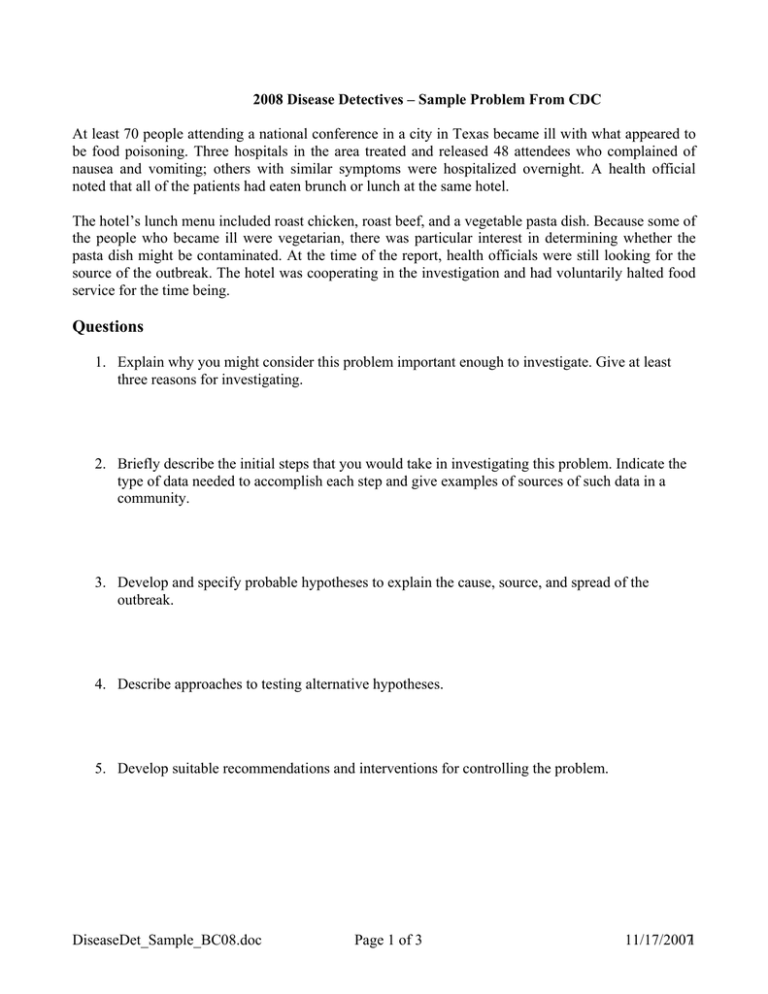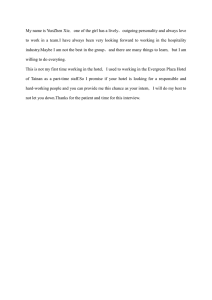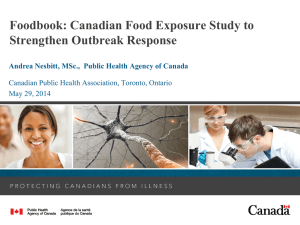Sample Exercise
advertisement

2008 Disease Detectives – Sample Problem From CDC At least 70 people attending a national conference in a city in Texas became ill with what appeared to be food poisoning. Three hospitals in the area treated and released 48 attendees who complained of nausea and vomiting; others with similar symptoms were hospitalized overnight. A health official noted that all of the patients had eaten brunch or lunch at the same hotel. The hotel’s lunch menu included roast chicken, roast beef, and a vegetable pasta dish. Because some of the people who became ill were vegetarian, there was particular interest in determining whether the pasta dish might be contaminated. At the time of the report, health officials were still looking for the source of the outbreak. The hotel was cooperating in the investigation and had voluntarily halted food service for the time being. Questions 1. Explain why you might consider this problem important enough to investigate. Give at least three reasons for investigating. 2. Briefly describe the initial steps that you would take in investigating this problem. Indicate the type of data needed to accomplish each step and give examples of sources of such data in a community. 3. Develop and specify probable hypotheses to explain the cause, source, and spread of the outbreak. 4. Describe approaches to testing alternative hypotheses. 5. Develop suitable recommendations and interventions for controlling the problem. DiseaseDet_Sample_BC08.doc Page 1 of 3 11/17/20071 Disease Detectives – Sample Problem Sample Problem: Answer Key 1. The problem appears serious because a large number of people attending the same event became ill with similar symptoms at the same time. Many of them were sick enough to need hospital care. Some of the reasons for investigating are to find out if a common infectious organism or toxic agent caused the illness, to prevent additional cases of illness from the same source, and to recommend ways of preventing the recurrence of this problem in another place or time. 2. Step 1: Confirm the diagnosis—you should first make certain that these people actually had gastroenteritis and that this report does not represent either a mistake in diagnosis or mass hysteria. Data Needs and Sources: You need to get diagnostic data from local doctors and hospital emergency room staff. Step 2: Confirm that an outbreak really occurred—you should show that the number of people with gastroenteritis in this group was higher than would normally be expected. Data Needs and Sources: You need to know how many people attended the meeting. Unfortunately, the press report does not give this information, but the hotel or the organization sponsoring the conference would be able to help. Step 3: Define and identify cases of illness—you will first need to develop a case definition using data on the symptoms, the time and place the illness occurred, and common characteristics of the people who were ill. Case Definition: "the onset of some combination of acute gastrointestinal symptoms (e.g., nausea, vomiting, diarrhea, and cramps) in a person attending the XYZ Conference held in Someplace, Texas, on June 4-6, 1998." Data Needs and Sources: To identify cases, you need to interview either all of the people attending the conference or a representative sample of those people. You might also interview hotel employees and food servers. You should be able to get addresses and telephone numbers for conference participants by asking the organizers for a copy of the master registration list. You would also need to contact area physicians, clinics, and hospital emergency rooms. 3. The news report stated that everyone who became ill had eaten brunch or lunch on Wednesday at the same hotel; that the menu included chicken, beef, and vegetable pasta; and that vegetarians were among those who became ill. Possible hypotheses are One or more of these food items was contaminated with a microorganism (bacteria or virus) or toxin that causes gastroenteritis. However, the newspaper account is probably incomplete, and beverages and other food items were probably served. If any of the foods or beverages are eventually proven to be contaminated, they would be considered a "common source" for the outbreak. DiseaseDet_Sample_BC08.doc Page 2 of 3 11/17/20072 It could be that none of the items served by the hotel over the lunch hour was contaminated and that people were exposed elsewhere. For example, those who became sick could have been together at a meeting someplace else where contaminated snacks and beverages were served during a break. 4. Two of the most important methods for testing hypotheses are cohort studies and case-control studies. Both use a comparison group to evaluate the relationships between different exposures and the risks of disease. The nature of the outbreak determines which of these studies is used. Cohort studies are used for outbreaks in small, well-defined populations, for which a complete list of participants is available. In this type of study, groups of people who have been exposed to suspected risk factors are compared with groups who have not been exposed. For example, in the gastroenteritis outbreak described here, you could use a cohort study to examine the role of each food and beverage item by determining and then comparing the "relative risk" of illness for each item. The relative risk for each item is calculated by dividing the illness incidence (or "attack rate") among people who ate or drank the item by the incidence among people who did not. Case-control studies compare people with a disease (case-patients) with a group of people without the disease (controls) and are used when the population is not well defined. In a casecontrol study, case-patients and controls are asked about their exposures. You compare the proportion of cases and controls exposed to each risk factor and use these proportions to calculate an "odds ratio," which is a measure of the relation between the exposure and likelihood of disease. 5. In the outbreak described above, the decision to shut down the hotel’s food service may have been based on preliminary findings of the investigation. Once the investigation pinpointed the source of the contaminated food, health officials might have included one or more of the following measures in their recommendations for food handlers: o Wash hands, knives, and cutting boards and other work surfaces after each handling of uncooked food. o Wash raw produce thoroughly before serving it or placing it on work surfaces for preparation. o Keep prepared produce refrigerated until served. o Keep uncooked meats separate from vegetables, cooked foods, and ready-to-eat foods. o Cook raw meat thoroughly. o Cook leftover foods or ready-to-eat foods until they are steaming hot. o Do not allow food workers to work when they are experiencing a gastrointestinal illness. DiseaseDet_Sample_BC08.doc Page 3 of 3 11/17/20073




